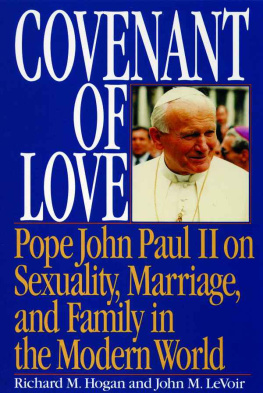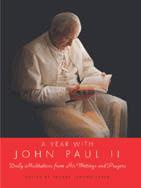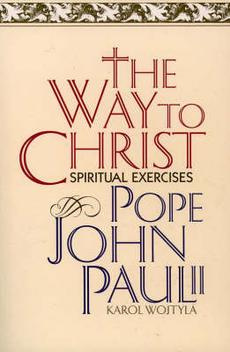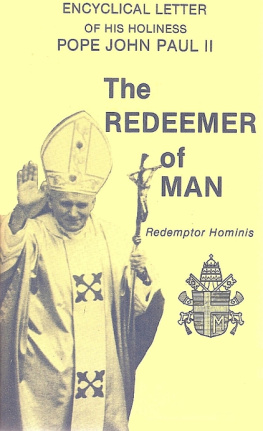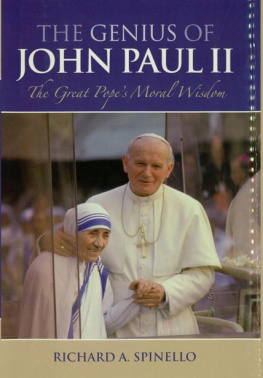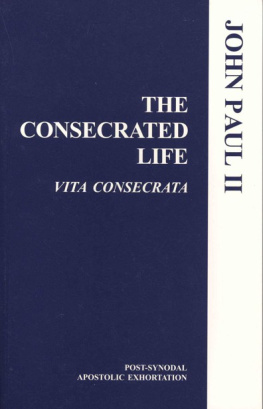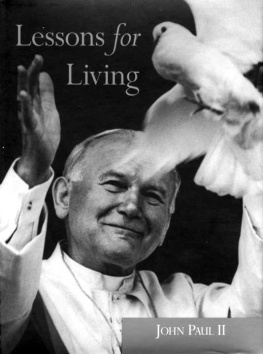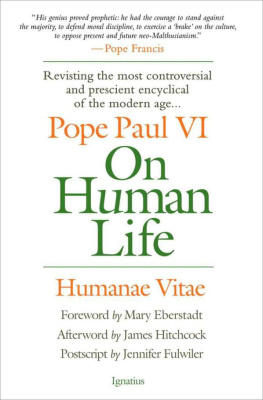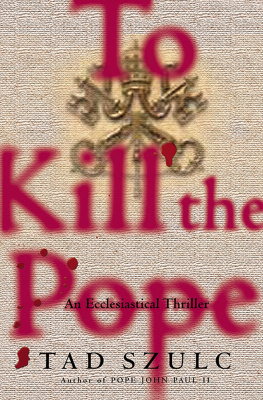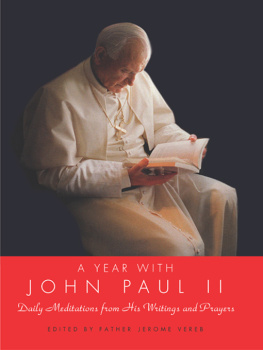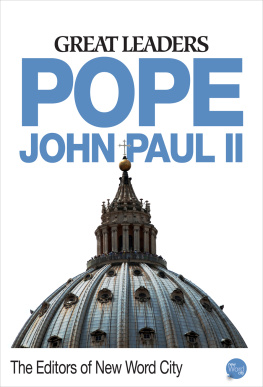Covenant of Love
R EV. R ICHARD M. H OGAN
R EV. J OHN M. L E V OIR
Covenant of Love
Pope John Paul II on
Sexuality, Marriage, and
Family in the Modern World
With a Commentary on Familiaris Consortio
IGNATIUS PRESS SAN FRANCISCO
First edition printed by Doubleday, Inc.
1985 by Richard M. Hogan and John M. LeVoir
All rights reserved
Published with ecclesiastical approval
Cover photograph: CNS / Arturo Mari
Second edition 1992, Ignatius Press
ISBN 0-89870-399-9
Library of Congress catalogue number 91-76516
Printed in the United States of America
Contents
PART ONE
THE FAMILY IN THE TEACHINGS
OF POPE JOHN PAUL II
A. The Papal Elections (1978)
B. Wojtyla and the Council
C. A New Presentation of the Gospel
A. The Human Person as an Image of God
B. Adam and Eve: The Body and Three Original Human Experiences
C. The Body and Original Sin
D. The Redemption of the Body: Presentation
E. The Redemption of the Body: Possible Difficulties
A. Man and Woman (Images of God) and Love
B. The Family as a Communion of Persons
C. Revisionist Sexual Morality: An Attack on the Family
D. Violations of the Familial Communion of Persons
1. Premarital Sex
2. Polygamy
3. Adultery and Lust
4. Abortion
5. Contraception and Artificial Conception
6. Homosexuality
E. Natural Family Planning
F. Virginity
G. Conclusion
A. Work: The Human Person Shares in the Creative Act
B. Worker Solidarity: A Communion of Persons
C. Work: For Man and for the Family
1. The Relationship of the Two Communions, Work and Family
2. The Two-Career Family
3. Women and Work
4. The Economic and Social Rights of the Family
D. Materialism: The Corruption of Work and the Family
E. Christ: The Redemption of Work and the Family
A. Christ, the Perfect Image of God
B. The Cross of Christ: The School of Love
C. The Work of Christ
D. The Work of Christ Continued: The Church
E. The Family as the Domestic Church
1. Baptism and Matrimony
2. The Priestly Office
3. The Prophetic Office
4. The Kingly Office
F. Conclusion
PART TWO
A COMMENTARY ON THE APOSTOLIC EXHORTATION
Familiaris Consortia , The Role of the Christian
Family in the Modern World
Foreword
And now the most eminent cardinals have called a new bishop of Rome. They have called him from a distant country, distant but always so close through the communion in the Christian faith and tradition. Talks of John Paul II
Karol Wojtyla was neither a recluse nor a stranger to much of the world when he accepted the duties of the Vicar of Christ on October 16, 1978. He had played a strong role in the proceedings of the Second Vatican Council and had served as a representative from his native Poland in each of the synods of bishops from the time of the institution of that forum.
It is unlikely, however, that anyone could have anticipated the extraordinary impact he has had on the world in these past six years. In part because of his travels and in part because of his obvious attractiveness to people, what he says and does receives the greatest possible attention.
What is becoming increasingly clear to me is that it is impossible to divorce the person of John Paul II from his teaching. In a world of personality peddlers, he comes through as integral and a person totally informed by his unwavering faithfulness to the Church of Christ.
Concern for truth is the Holy Fathers basic preoccupation. He is able to teach people hard truths. He preaches chastity to an age that has pretty much rejected chastity. He teaches the Values of family life to a world that is pretty cavalier about those values; There is an extraordinary consistency about John Paul II, the man and the teacher. He is the product of a living, growing faith, and his roots are set solidly not only in his native Poland but in the Second Vatican Council. His mission in life is to share his vision of faith and the vision of that Council with all who will listen.
As early as 1972, when he published Sources of Renewal , the cardinal archbishop of Cracow patiently explained what the teaching of the Council was. Now, with a much larger platform he brings that same message to the entire world. The secret of John Paul IIs consistency in teaching is that today he is guided by the same Holy Spirit who inspired him and his brother bishops when they drafted the conciliar documents.
In an extraordinary statement, the conciliar fathers taught that our Lord Jesus Christ fully reveals man to himself ( Pastoral Constitution on the Church in the Modern World , no. 22). Of course, within John Pauls new and most interesting theological system this statement is clearly associated with Gods revelation in Genesis that human beings are made to the image and likeness of God. Obviously, if we are like God, we do not know ourselves unless we know God.
That central insight in the Holy Fathers approach to faith lies in Gods revelation in Genesis and Christs fulfillment of creation. This insight has dictated his teachings on sexuality and family life.
It is not possible to fragment the teaching of this pope. You really dont understand what he says about sexuality and the family without understanding his entire system of thought.
It is my belief that Fathers Hogan and LeVoir have not only provided this background in the first part of this volume, but they have also applied their studies of his thought to the most important document the Holy See has issued on the family, Familiaris Consortio, The Role of the Christian Family in the Modern World . It is my hope that this volume will be an enrichment to the many who look for truth from a man who spends his life in the cause of truth.
THE MOST REVEREND JOHN R. ROACH
Past President, National Conference of Catholic Bishops
Preface
The authors of this volume have incurred a responsibility toward John Paul II. They have received the priceless gift of the truth in the teachings of the present successor to Saint Peter. In accepting such a gift, the authors have incurred an obligation to make some repayment. In a sense, they have a debt to John Paul IIa debt which they now desire to discharge. Since the Holy Father wishes his teachings to be made known to all people, the authors, through this work, wish to repay the Holy Father in a small way by making his masterful preaching of the gospel better known and understood, especially as it relates to sexuality and family matters.
This volume is divided into two parts. The first part, in five chapters, is an analysis of John Paul IIs new synthesis as applied to sexuality and family life. The first chapter briefly examines John Pauls revolutionary new synthesis of faith and reason. The next four chapters consider the human person as an individual, as a member of the communion of persons of the family, as a member of the communion of persons existing among all workers, and as a member of the mystical person of Christ, the Church. Sexuality and family life are discussed extensively in the second and third chapters. The second chapter considers the individual human person as an image of God called to love in and through the body. The third chapter examines the expression of love within the family. Clearly, these chapters are closely related and a few of the same topics are discussed in both. However, we have striven to limit the duplications. The second chapter will discuss those areas that pertain more to the individual, e.g., sterilization, and the third, those that pertain more to a couple, e.g., premarital sexual contact. But since the family in many modern societies has been devalued by a fundamental misunderstanding of the relationship of man and work, John Paul IIs view of sexuality and family life is incomprehensible without an understanding of the Holy Fathers considerations on work. The application of John Pauls new synthesis to work corrects the false understanding of work and situates it within the context of human and family values. Thus, it is only through a comprehension of the Holy Fathers revolutionary view of work that the family can be restored to its proper position in society. Therefore, the chapter on work is essential to this study of John Pauls vision of family and family life. Finally, the Holy Father describes the family as the domestic church. As such, it cannot be understood without knowing who the Church is.
Next page
